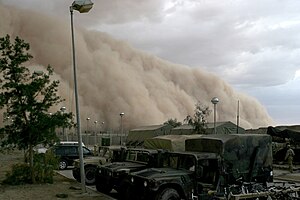Dust storm

A sand storm (or sandstorm in some contexts) is a meteorological phenomenon common in dry, arid and semi-arid regions. Such a storm is usually the rpesult of convection currents created by intense heating of the ground. These currents then carry clouds of sand over large distances.
Origins
Usually, a dust storm is a result of convection currents forming from hot ground. These currents can create winds that blow up to 120 km/h. These storms are often very large and can move whole sand dunes. Dust storms can carry large amounts of dust, so much so that the leading edge of one can appear as a solid wall of dust as much as 1,525 m high. Dust storms often come off the Sahara Desert with the global trade winds. These are also known as a simoom or simoon (sîmūm, sîmūn). The haboob (həbūb) is a sandstorm prevalent in the region of Sudan around Khartoum. Drought and wind contribute to the emergence of dust storms, as do poor farming and grazing practices by exposing the dust and sand to the wind.
Notable dust storms
- One that occurred near Tucson, Arizona, USA on July 16, 1971 was extensively documented by meteorologists.
- On the afternoon of February 8, 1983, a huge dust storm or
in the Mallee region of Victoria, Australia covered Melbourne.
- On Saturday afternoon of February 24, 2007, a large dust storm originating in the west Texas area of Amarillo covered much of the North Texas area. Strong winds caused extensive property damage to fences, roof shingles, and some buildings. The DFW Airport was severely affected causing extensive flight delays into and out of the DFW area. Area residents suffered respiratory problems and allergic reactions causing many people to visit hospitals.
Gallery
From space
-
Dust plume off the Sahara desert over the northeast Atlantic Ocean.
-
Dust storm in Burkina Faso
-
Mars dust storm
See also
External links
- Slide Show of a Dust Storm in Lubbock, Texas on December 15, 2003
- Dust in the Wind
- Fearful dust storm inspires songwriter —origin of Woody Guthrie's song "So Long, It's Been Good To Know You"
- Video of a dust storm in Al Asad Iraq, April 27, 2005
- Video of a Sahara Sandstorm
- Photos of dust storms hosted by the Portal to Texas History.
- The Bibliography of Aeolian Research
- Storms tear through Texas, neighbor states; Property damage, fires, injuries reported; Arkansas hit hardest
- Dallas dust storm causes LAX delays, cancellations
- Dallas dust storm causes LAX delays, cancellations











